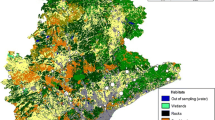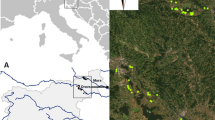Abstract
Abandoned fields are perceived as potential habitats for species of threatened semi-natural dry grasslands. However, information is lacking regarding how the spontaneous colonization of abandoned fields depends on the broader spatial context. We recorded the occurrence of 87 target species in 46 abandoned fields and 339 dry grasslands. We tested the effect of the isolation of abandoned fields from source grasslands on the number of dry grassland species occurring in abandoned fields either with or without habitat characteristics being used as covariates. The isolation of the fields was calculated using the distance and area (I A ) or distance and species richness (I S ) of source habitats. I S always explained the number of grassland species in the abandoned fields better than I A . The effect of isolation became smaller or even non-significant with the inclusion of covariates; it also changed with the method used for measuring distance (edge-to-edge or center-to-center), and it was lower when other abandoned fields were considered as additional source habitats. The different performance of the two isolation measures can be explained by the weak species–area relationship in the grasslands, indicating differences in their habitat quality. Species richness is a better proxy of habitat importance in terms of propagule source than habitat area, and the new isolation measure is therefore suitable for studying the effects of landscape structure on species richness in landscapes presenting a weak species–area relationship, such as areas exhibiting pronounced effects of land-use history. Inclusion of habitat characteristics as covariates may considerably alter conclusions regarding the effect of isolation, which might actually be overestimated when assessed separately.

Similar content being viewed by others
References
Adriaens D, Honnay O, Hermy M (2006) No evidence of a plant extinction debt in highly fragmented calcareous grasslands in Belgium. Biol Conserv 133(2):212–224
Bartha S, Meiners SJ, Pickett STA, Cadenasso ML (2003) Plant colonization windows in a mesic old field succession. Appl Veg Sci 6(2):205–212
Bennie J, Hill MO, Baxter R, Huntley B (2006) Influence of slope and aspect on long-term vegetation change in British chalk grasslands. J Ecol 94(2):355–368
Bruckmann SV, Krauss J, Steffan-Dewenter I (2010) Butterfly and plant specialists suffer from reduced connectivity in fragmented landscapes. J Appl Ecol 47(4):799–809
Bruun HH (2005) A field test of the relationship between habitat area and population size for five perennial plant species. Web Ecol 5:1–5
Chylova T, Munzbergova Z (2008) Past land use co-determines the present distribution of dry grassland plant species. Preslia 80(2):183–198
Cook WM, Yao J, Foster BL, Holt RD, Patrick LB (2005) Secondary succession in an experimentally fragmented landscape: community patterns across space and time. Ecology 86(5):1267–1279
Cousins SAO (2001) Analysis of land-cover transitions based on 17th and 18th century cadastral maps and aerial photographs. Landscape Ecol 16(1):41–54
Cousins SAO (2009a) Landscape history and soil properties affect grassland decline and plant species richness in rural landscapes. Biol Conserv 142(11):2752–2758
Cousins SAO (2009b) Extinction debt in fragmented grasslands: paid or not? J Veg Sci 20(1):3–7
Cousins SAO, Aggemyr E (2008) The influence of field shape, area and surrounding landscape an plant species richness in grazed ex-fields. Biol Conserv 141(1):126–135
Cousins SAO, Eriksson O (2008) After the hotspots are gone: land use history and grassland plant species diversity in a strongly transformed agricultural landscape. Appl Veg Sci 11(3):365–374
Crawley MJ (2002) Statistical computing: An introduction to data analysis using S-Plus. Wiley, Chichester
Ellenberg H (1988) Vegetation ecology of Central Europe. Cambridge University Press, Cambridge
Eriksson O, Ehrlen J (2001) Landscape fragmentation and the viability of plant populations. In: Silvertown J, Antonovics J (eds) Integrating ecology and evolution in spatial context. Blackwell, Oxford, pp 157–175
Eriksson A, Eriksson O, Berglund H (1995) Species abundance patterns of plants in Swedish seminatural pastures. Ecography 18(3):310–317
Eriksson O, Cousins SAO, Bruun HH (2002) Land-use history and fragmentation of traditionally managed grasslands in Scandinavia. J Veg Sci 13(5):743–748
ESRI (2006) ArcGIS 9.2. Environmental Systems Research Institute, Redlands
Gustavsson E, Lennartsson T, Emanuelsson M (2007) Land use more than 200 years ago explains current grassland plant diversity in a Swedish agricultural landscape. Biol Conserv 138(1–2):47–59
Hanski I (1994) A practical model of metapopulation dynamics. J Anim Ecol 63(1):151–162
Hanski I (1999) Habitat connectivity, habitat continuity, and metapopulations in dynamic landscapes. Oikos 87(2):209–219
Hartnett DC, Wilson GWT (1999) Mycorrhizae influence plant community structure and diversity in tallgrass prairie. Ecology 80(4):1187–1195
Helm A, Hanski I, Partel M (2006) Slow response of plant species richness to habitat loss and fragmentation. Ecol Lett 9(1):72–77
Hermy M, Honnay O, Firbank L, Grashof-Bokdam C, Lawesson JE (1999) An ecological comparison between ancient and other forest plant species of Europe, and the implications for forest conservation. Biol Conserv 91(1):9–22
Honnay O, Degroote B, Hermy M (1998) Ancient-forest plant species in Western Belgium: a species list and possible ecological mechanisms. Belg J Bot 130(2):139–154
Janssens F, Peeters A, Tallowin JRB, Bakker JP, Bekker RM, Fillat F, Oomes MJM (1998) Relationship between soil chemical factors and grassland diversity. Plant Soil 202(1):69–78
Karlik P, Poschlod P (2009) History or abiotic filter: which is more important in determining the species composition of calcareous grasslands? Preslia 81(4):321–340
Kindlmann P, Burel F (2008) Connectivity measures: a review. Landscape Ecol 23(8):879–890
Kiviniemi K (2008) Effects of fragment size and isolation on the occurrence of four short-lived plants in semi-natural grasslands. Acta Oecol 33(1):56–65
Kiviniemi K, Eriksson O (1999) Dispersal, recruitment and site occupancy of grassland plants in fragmented habitats. Oikos 86(2):241–253
Lindborg R, Eriksson O (2004) Historical landscape connectivity affects present plant species diversity. Ecology 85(7):1840–1845
Lindborg R, Cousins SAO, Eriksson O (2005) Plant species response to land use change—Campanula rotundifolia, Primula veris and Rhinanthus minor. Ecography 28(1):29–36
Lipsky Z (1995) The changing face of the Czech Rural landscape. Landsc Urban Plan 31(1–3):39–45
Lobel S, Dengler J, Hobohm C (2006) Species richness of vascular plants, bryophytes and lichens in dry grasslands: the effects of environment, landscape structure and competition. Folia Geobot 41(4):377–393
Loehle C (2007) Effect of ephemeral stepping stones on metapopulations on fragmented landscapes. Ecol Complex 4:42–47
Luoto M, Rekolainen S, Aakkula J, Pykala J (2003) Loss of plant species richness and habitat connectivity in grasslands associated with agricultural change in Finland. Ambio 32(7):447–452
MathSoft Inc (1999) S-Plus 2000 Professional Release 2.Data Analysis Products Division. MathSoft, Seattle
Moilanen A, Nieminen M (2002) Simple connectivity measures in spatial ecology. Ecology 83(4):1131–1145
Munzbergova Z (2004) Effect of spatial scale on factors limiting species distributions in dry grassland fragments. J Ecol 92(5):854–867
Oehl F, Laczko E, Bogenrieder A, Stahr K, Bosch R, van der Heijden M, Sieverding E (2010) Soil type and land use intensity determine the composition of arbuscular mycorrhizal fungal communities. Soil Biol Biochem 42(5):724–738
Oster M, Cousins SAO, Eriksson O (2007) Size and heterogeneity rather than landscape context determine plant species richness in semi-natural grasslands. J Veg Sci 18(6):859–868
Oster M, Ask K, Cousins SAO, Eriksson O (2009a) Dispersal and establishment limitation reduces the potential for successful restoration of semi-natural grassland communities on former arable fields. J Appl Ecol 46(6):1266–1274
Oster M, Ask K, Romermann C, Tackenberg O, Eriksson O (2009b) Plant colonization of ex-arable fields from adjacent species-rich grasslands: the importance of dispersal vs recruitment ability. Agr Ecosyst Environ 130(3–4):93–99
Pandit SN, Kolasa J, Cottenie K (2009) Contrasts between habitat generalists and specialists: an empirical extension to the basic metacommunity framework. Ecology 90(8):2253–2262
Partel M, Zobel M (1999) Small-scale plant species richness in calcareous grasslands determined by the species pool, community age and shoot density. Ecography 22(2):153–159
Poschlod P, Bonn S (1998) Changing dispersal processes in the central European landscape since the last ice age: an explanation for the actual decrease of plant species richness in different habitats? Acta Bot Neerl 47(1):27–44
Postma-Blaauw MB, de Goede RGM, Bloem J, Faber JH, Brussaard L (2010) Soil biota community structure and abundance under agricultural intensification and extensification. Ecology 91(2):460–473
Prugh LR (2009) An evaluation of patch connectivity measures. Ecol Appl 19(5):1300–1310
Pykala J, Luoto M, Heikkinen RK, Kontula T (2005) Plant species richness and persistence of rare plants in abandoned semi-natural grasslands in northern Europe. Basic Appl Ecol 6(1):25–33
Pywell RF, Bullock JM, Hopkins A, Walker KJ, Sparks TH, Burke MJW, Peel S (2002) Restoration of species-rich grassland on arable land: assessing the limiting processes using a multi-site experiment. J Appl Ecol 39(2):294–309
Reitalu T, Sykes MT, Johansson LJ, Lonn M, Hall K, Vandewalle M, Prentice HC (2009) Small-scale plant species richness and evenness in semi-natural grasslands respond differently to habitat fragmentation. Biol Conserv 142(4):899–908
Ruprecht E (2006) Successfully recovered grassland: a promising example from Romanian old-fields. Restor Ecol 14(3):473–480
Tremlova K, Munzbergova Z (2007) Importance of species traits for species distribution in fragmented landscapes. Ecology 88(4):965–977
Tutin TG, Heywood VH, Burges NA, Moore DM, Valentine DH, Walters SM, Webb DA (eds) (1964–1983). Flora Europaea. Cambridge University Press, New York
van der Heijden MGA, Bardgett RD, van Straalen NM (2008) The unseen majority: soil microbes as drivers of plant diversity and productivity in terrestrial ecosystems. Ecol Lett 11(3):296–310
Walker KJ, Stevens PA, Stevens DP, Mountford JO, Manchester SJ, Pywell RF (2004) The restoration and re-creation of species-rich lowland grassland on land formerly managed for intensive agriculture in the UK. Biol Conserv 119(1):1–18
Web 1. http://portal.chmi.cz/. Downloaded 26 Apr 2011
With KA, Crist TO (1995) Critical thresholds in species responses to landscape structure. Ecology 76(8):2446–2459
Acknowledgments
We thank Ondra Beran, Zita Cervenkova, Michal Knapp, Dana Pruchova, Katka Tremlova and Jana Zmeskalova for their help in the field. We are grateful to Michal Knapp, people from the Population Ecology discussion group in Pruhonice and two anonymous referees for valuable comments on previous versions of the manuscript. This study was supported by the Grant Agency of Czech Republic (Grant no. P505/10/0593 and partly also no. 206/08/H049), and partly by the Ministry of Education, Youth and Sports of the Czech Republic (Grant no. 0021620828) and Academy of Sciences of the Czech Republic (Grant no. AV0Z60050516).
Author information
Authors and Affiliations
Corresponding author
Electronic supplementary material
Below is the link to the electronic supplementary material.
Rights and permissions
About this article
Cite this article
Knappová, J., Hemrová, L. & Münzbergová, Z. Colonization of central European abandoned fields by dry grassland species depends on the species richness of the source habitats: a new approach for measuring habitat isolation. Landscape Ecol 27, 97–108 (2012). https://doi.org/10.1007/s10980-011-9680-5
Received:
Accepted:
Published:
Issue Date:
DOI: https://doi.org/10.1007/s10980-011-9680-5




